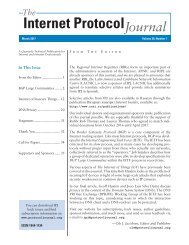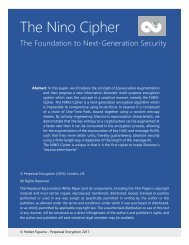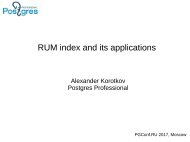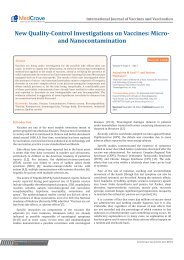Create successful ePaper yourself
Turn your PDF publications into a flip-book with our unique Google optimized e-Paper software.
<strong>Captain</strong> <strong>Hook</strong>:<br />
Pirating AVS to Bypass Exploit Mitigations
WHO?<br />
Udi Yavo<br />
• CTO and Co-Founder, enSilo<br />
• Former CTO, Rafael Cyber Security Division<br />
• Researcher<br />
• Author on BreakingMalware<br />
Tomer Bitton<br />
• VP Research and Co-Founder, enSilo<br />
• Low Level Researcher, Rafael Advanced Defense Systems<br />
• Malware Researcher<br />
• Author on BreakingMalware
AGENDA<br />
• <strong>Hook</strong>ing In a Nutshell<br />
• Scope of Research<br />
• Inline <strong>Hook</strong>ing – Under the hood<br />
- 32-bit function hooking<br />
- 64-bit function hooking<br />
• <strong>Hook</strong>ing Engine Injection Techniques<br />
• The 6 Security Issues of <strong>Hook</strong>ing<br />
• Demo – Bypassing exploit mitigations<br />
• 3 rd Party <strong>Hook</strong>ing Engines<br />
• Affected Products<br />
• Research Tools<br />
• Summary
HOOKING IN A NUTSHELL<br />
• <strong>Hook</strong>ing is used to intercept function calls in order to alter or<br />
augment their behavior<br />
• Used in most endpoint security products:<br />
• Anti-Exploitation – EMET, Palo-Alto Traps, …<br />
• Anti-Virus – Almost all of them<br />
• Personal Firewalls – Comodo, Zone-Alarm,…<br />
• …<br />
• Also used in non-security products for various purposes:<br />
• Application Performance Monitoring (APM)<br />
• Application Virtualization (Microsoft App-V)<br />
• Used in Malware:<br />
• Man-In-The-Browser (MITB)
SCOPE OF RESEARCH<br />
• Our research encompassed about a dozen security products<br />
• Focused on user-mode inline hooks – The most common hooking<br />
method in real-life products<br />
• <strong>Hook</strong>s are commonly set by an injected DLL. We’ll refer to this DLL<br />
as the “<strong>Hook</strong>ing Engine”<br />
• Kernel-To-User DLL injection techniques<br />
• Used by most vendors to inject their hooking engine<br />
• Complex and leads security issues
Inline <strong>Hook</strong>ing
INLINE HOOKING – 32-BIT FUNCTION HOOKING<br />
Straight forward most of the time:<br />
Disassemble<br />
Prolog<br />
Allocate<br />
Code Stub<br />
Copy Prolog<br />
Instructions<br />
Patch the<br />
Prolog with a<br />
JMP
INLINE HOOKING – 32-BIT FUNCTION HOOKING<br />
InternetConnectW before the hook is set:<br />
InternetConnectW After the hook is set:
INLINE HOOKING – 32-BIT FUNCTION HOOKING<br />
The hooking function (0x178940)<br />
The Copied Instructions<br />
Original Function Code
INLINE HOOKING – 32-BIT FUNCTION HOOKING<br />
• Other Techniques:<br />
• One Byte Patching (Malware) - Patch with an illegal instruction and catch in<br />
the exception handler<br />
• Microsoft Hot Patching – Only 2 bytes function prolog overwrite<br />
• Some Possible Complications:<br />
• Relative jmp/call in the prolog<br />
• Very short functions/short prolog<br />
• jmp/jxx to the middle of the prolog’s instruction<br />
• …<br />
<strong>Hook</strong>ing Function
INLINE HOOKING – 64-BIT FUNCTION HOOKING<br />
• More complex<br />
• 5 bytes jmp instruction might not be enough (limited to a 2GB range)<br />
Disassemble<br />
Prolog<br />
Allocate<br />
Trampoline<br />
Allocate<br />
Code Stub<br />
Write<br />
Trampoline<br />
Copy Prolog<br />
Instructions<br />
Patch the<br />
Prolog with a<br />
JMP<br />
MOV RAX, <br />
JMP RAX
INLINE HOOKING – 64-BIT FUNCTION HOOKING<br />
• InternetConnectA before the hook is set:<br />
• InternetConnectA after the hook is set:<br />
• Trampoline code:
INLINE HOOKING – 64-BIT FUNCTION HOOKING<br />
If we follow the hooking function we get:<br />
Original Function Code
INLINE HOOKING – 64-BIT FUNCTION HOOKING<br />
• Other Techniques:<br />
• 6 Bytes patching (requires hooks’ code stub to be in 32-bit address)<br />
• Double Push (Nikolay Igotti) – Preserves all registers<br />
Jumps to 0x7ffc00030000<br />
• …<br />
• Possible Complications:<br />
• Similar to 32-bit hooks<br />
• More instruction pointer relative instructions:<br />
MOV RAX, QWORD [RIP+0x15020]
INLINE HOOKING – RECAP<br />
• Inline hooking is the most common hooking technique in real-life products<br />
• Rather intrusive – modifies the code of the of hooking function<br />
• Used by most endpoint security products<br />
• More on hooking:<br />
• Binary <strong>Hook</strong>ing Problems - By Gil Dabah<br />
• Trampolines in X64 - By Gil Dabah<br />
• Powerful x86/x64 Mini <strong>Hook</strong>-Engine - Daniel Pistelli<br />
• Inline <strong>Hook</strong>ing for Programmers - Malware Tech<br />
• …
Kernel-To-User Code Injections
INTRODUCTION - KERNEL-TO-USER CODE INJECTIONS<br />
• Mainly used for:<br />
• Injecting DLLs<br />
• Sandbox escapes – After exploiting privilege<br />
escalation vulnerability<br />
• Injecting to protected processes<br />
• Fewer techniques exist than user-mode<br />
• Less documented than user-mode techniques<br />
• Used by both Malware and Software/Security vendors
INJECTION METHODS – USER APC<br />
• The most common Kernel-To-User injection method<br />
• Used by lots of malwares:<br />
• TDL<br />
• ZERO ACCESS<br />
• Sandbox escape shellcodes<br />
• …<br />
• Also used by lots of security products:<br />
• AVG<br />
• Kaspersky Home Edition<br />
• Avecto<br />
• …<br />
• Documented:<br />
• Blackout: What Really Happened<br />
• Much more in forums and leaked source codes
INJECTION METHODS – USER APC<br />
Basic Steps (There are several variations):<br />
1. Register load image callback using PsSetLoadImageNotifyRoutine<br />
2. Write payload that injects a dll using LdrLoadDll<br />
(Other variations use LoadLibrary)<br />
3. Insert User APC using KeInsertQueueApc
INJECTION METHODS – ENTRY POINT PATCHING<br />
• Not really common but worth mentioning<br />
• Used by Duqu<br />
• Fully documented in:<br />
http://binsec.gforge.inria.fr/pdf/Malware2013-Analysis-Diversion-Duqu-paper.pdf
INJECTION METHODS – ENTRY POINT PATCHING<br />
• Register load image callback using PsSetLoadImageNotifyRoutine<br />
and wait for main module to load<br />
Kernel Space<br />
Ntoskrnl.exe<br />
KiStartUserThread<br />
EvilDriver.sys<br />
Callback Routine<br />
User Space<br />
Application<br />
RtlUserThreadStart<br />
Process Image
INJECTION METHODS – ENTRY POINT PATCHING<br />
• Write the payload to the process address space<br />
Kernel Space<br />
Ntoskrnl.exe<br />
KiStartUserThread<br />
EvilDriver.sys<br />
Callback Routine<br />
User Space<br />
Application<br />
RtlUserThreadStart<br />
Process Image<br />
Payload
INJECTION METHODS – ENTRY POINT PATCHING<br />
• Replace the image entry point with JMP to the new code<br />
Kernel Space<br />
Ntoskrnl.exe<br />
KiStartUserThread<br />
EvilDriver.sys<br />
Callback Routine<br />
User Space<br />
JMP Payload<br />
Application<br />
RtlUserThreadStart<br />
Process Image<br />
Payload
INJECTION METHODS – ENTRY POINT PATCHING<br />
• The payload executes, fixes the entry point and jumps to it<br />
Kernel Space<br />
Ntoskrnl.exe<br />
KiStartUserThread<br />
EvilDriver.sys<br />
Callback Routine<br />
User Space<br />
JMP Payload<br />
Application<br />
RtlUserThreadStart<br />
Process Image<br />
Payload<br />
Jump to entry point
INJECTION METHODS – ENTRY POINT PATCHING<br />
• Internet Explorer patched entrypoint
INJECTION METHODS – IMPORT TABLE PATCHING<br />
• First published on Codeless-Code-Injections talk (to our knowledge)<br />
• Never been used by malware (to our knowledge)<br />
• Used by software and security vendors:<br />
• Symantec<br />
• Trusteer<br />
• Microsoft App-V<br />
• Similar method could probably use TLS data directory
INJECTION METHODS – IMPORT TABLE PATCHING<br />
1. Register load image callback using<br />
PsSetLoadImageNotifyRoutine and wait for main<br />
module to load<br />
2. Allocate memory for the new import table and copy<br />
old table with a new record for the injected DLL<br />
3. Point the import data directory to the new<br />
table<br />
4. When the DLL is loaded the original PE<br />
header is restored<br />
Before<br />
PE Header MZ Header<br />
After<br />
PE Header MZ Header<br />
Injected DLL Descriptor<br />
Import Descriptor 1<br />
DOS Stub<br />
DOS Stub<br />
Import Descriptor 2<br />
File Header<br />
File Header<br />
…<br />
Optional Header<br />
Optional Header<br />
Data Directories<br />
Imports<br />
Data Directories<br />
Imports<br />
…<br />
…<br />
Import Descriptor 1<br />
Import Descriptor 1<br />
Import Descriptor 2<br />
Import Descriptor 2
INJECTION METHODS – IMPORT TABLE PATCHING<br />
Internet Explorer patched import table
INJECTION METHODS – NTDLL.DLL/USER32.DLL PATCHING<br />
• Register load image callback using PsSetLoadImageNotifyRoutine<br />
and wait for ntdll.dll module to load<br />
Kernel Space<br />
Ntoskrnl.exe<br />
KiStartUserThread<br />
EvilDriver.sys<br />
Callback Routine<br />
User Space<br />
Application<br />
RtlUserThreadStart<br />
LdrLoadDll
INJECTION METHODS – NTDLL.DLL/USER32.DLL PATCHING<br />
• Write the payload to the process address space<br />
Kernel Space<br />
Ntoskrnl.exe<br />
KiStartUserThread<br />
EvilDriver.sys<br />
Callback Routine<br />
User Space<br />
Application<br />
RtlUserThreadStart<br />
LdrLoadDll<br />
Payload
INJECTION METHODS – NTDLL.DLL/USER32.DLL PATCHING<br />
• Replace the LdrLoadLibrary prolog with JMP (or equivalent) to the payload<br />
Kernel Space<br />
Ntoskrnl.exe<br />
KiStartUserThread<br />
EvilDriver.sys<br />
Callback Routine<br />
User Space<br />
JMP Payload<br />
Application<br />
RtlUserThreadStart<br />
LdrLoadDll<br />
Payload
INJECTION METHODS – NTDLL.DLL/USER32.DLL PATCHING<br />
• The payload loads a dll, fixes LdrLoadDll and jumps to it<br />
Kernel Space<br />
Ntoskrnl.exe<br />
KiStartUserThread<br />
EvilDriver.sys<br />
Callback Routine<br />
User Space<br />
JMP Payload<br />
Application<br />
RtlUserThreadStart<br />
LdrLoadDll<br />
Payload<br />
Jump to LdrLoadDll
INJECTION METHODS – QUICK SUMMARY<br />
• Kernel-To-User Injections are extensively used by both<br />
malware and security/software products<br />
• Kernel injections are mainly used to inject a DLL to<br />
target processes<br />
• In security products the injected DLL is commonly the<br />
hooking engine<br />
• Prone to mistakes – due to its relative complexity
The 6 security issues of hooking
#1 – UNSAFE INJECTION<br />
Severity: Very High<br />
Affected Systems: All Windows Versions<br />
Occurs due to bad DLL injection implementation<br />
• We found 2 types of unsafe injections:<br />
• LoadLibrary from a relative path – vulnerable<br />
to DLL Hijacking<br />
• Unprotected injected DLL file – placed in<br />
%appdata%\Local\Vendor<br />
Can easily be replaced by the attacker
#2 – PREDICTABLE RWX CODE STUBS<br />
Severity: Very High<br />
Affected Systems: All Windows Versions<br />
The Kernel-To-User DLL injection allocates RWX code in a<br />
predictable location<br />
Functions pointers in constant addresses<br />
RWX Permissions<br />
• Implications:<br />
• ASLR Bypass – The code stubs normally contains<br />
addresses of critical OS functions<br />
• Great for shellcode – Allows writing malicious code<br />
to the allocated code-stub
#3 – PREDICTABLE R-X CODE STUBS<br />
Severity: Very High<br />
Affected Systems: All Windows Versions<br />
The Kernel-To-User DLL injection or hooking engine<br />
allocates R-X code in a predictable location<br />
Implications:<br />
• ASLR Bypass – The code stubs contain the addresses<br />
of critical OS functions<br />
• <strong>Hook</strong>s Bypass – Calling the hook code stub<br />
effectively bypasses the hook<br />
• Code Reuse – The code can also be useful for ROP
#4 – PREDICTABLE RWX CODE STUBS 2<br />
Severity: High<br />
Affected Systems: Windows 7 and Below<br />
The Kernel-To-User DLL injection allocates RWX code<br />
without specifying exact address<br />
Implications:<br />
• Similar to the first predictable RWX Code issue
#5 –RWX CODE STUBS<br />
Severity: Medium<br />
Affected Systems: All Windows Versions<br />
The most common issue: most hooking engines leave their<br />
hook code stubs as RWX<br />
The implication - possible CFG bypass:<br />
• Get arbitrary read/write in the target process<br />
• Find the hook’s stub (R)<br />
• Overwrite it (W)<br />
• Trigger the execution of the hooked function (X)<br />
* Note: Attacker with arbitrary read/write will probably succeed anyway
#6 –RWX HOOKED MODULES<br />
Severity: Medium<br />
Affected Systems: All Windows Versions<br />
Some hooking engines leave the code of the hooked<br />
modules as RWX<br />
The implication - possible CFG bypass<br />
LdrLoadDll <strong>Hook</strong><br />
RWX Permissions
SECURITY ISSUES OF HOOKING - RECAP
Demo<br />
Bypassing Exploit Mitigations
3 rd Party <strong>Hook</strong>ing Engines
3 RD PARTY HOOKING ENGINES<br />
• Developing a hooking engine is not an easy task<br />
• Using open-source* or commercial hooking engines has many advantages:<br />
• Easy API to work with<br />
• Supports many platforms<br />
• Saves development effort<br />
• Saves testing effort<br />
• 3 rd party hooking engines are also integrated into non-security products<br />
• A security issue in a hooking engine results in many patches…<br />
* We really like Gil Dabah’s distormx
EASYHOOK – OPEN-SOURCE HOOKING ENGINE<br />
• Used by many open-source projects<br />
• Also used by a few security vendors. For example, Vera<br />
Features:<br />
• Kernel <strong>Hook</strong>ing support<br />
• Thread Deadlock Barrier<br />
• RIP-relative address relocation for 64-bit<br />
• …<br />
Security Issues:<br />
• RWX <strong>Hook</strong> Code Stubs<br />
• RWX <strong>Hook</strong>ed Modules<br />
Bad Practice:<br />
• Uses Non-Executable heap and changes parts of it to code
DEVIARE2 - OPEN-SOURCE HOOKING ENGINE<br />
• Dual License – Commercial or GPL for open-source<br />
• Fixed the issues quickly<br />
• From their web site:<br />
Features:<br />
“Several Fortune 500 companies are using Deviare technology for application<br />
virtualization, packaging, and troubleshooting, and for computer security.”<br />
• Defer <strong>Hook</strong> –Set a hook only when and if a module is loaded<br />
• .NET Function hooking<br />
• Interface for many languages: (C++, VB, Python, C#,…)<br />
• …<br />
Security Issues:<br />
• RWX <strong>Hook</strong> Code Stubs
MADCODEHOOK – POWERFUL COMMERCIAL HOOKING<br />
• Used by a lot for security vendors (75% of its users)<br />
• Used by emsisoft<br />
• Fixed the issues quickly<br />
Features:<br />
• Injection Driver – Used to perform kernel-injection into processes<br />
• IPC API –Used to easily communicate with some main process<br />
• IAT <strong>Hook</strong>ing<br />
• …<br />
Security Issues:<br />
• RWX <strong>Hook</strong> Code Stubs
MICROSOFT DETOURS<br />
• The most popular hooking engine in the world<br />
• Microsoft’s App-V uses Detours which is integrated into Office<br />
• We were surprised to find out that it has problems too…<br />
Features:<br />
• ARM support<br />
• …<br />
Security Issues:<br />
• Predictable RX (Universal).<br />
* Details won’t be revealed until the patch is released (September)
MICROSOFT DETOURS VULNERABILITY - IMPLICATIONS<br />
• Microsoft’s hooking engine Detours – via Microsoft.com:<br />
“Under commercial release for over 10 years, Detours is licensed by over 100 ISVs and used<br />
within nearly every product team at Microsoft.”<br />
• Could potentially affect millions of users<br />
• Also used in security products<br />
• Hard to patch - In most cases fixing this issue requires recompilation of<br />
each product individually which makes patching cumbersome
Affected Products
AFFECTED PRODUCTS<br />
* Patch wasn’t released yet<br />
Products/Vendors<br />
UnSafe<br />
Injection<br />
Predictable<br />
RWX(Universal)<br />
Predictable<br />
RX(Universal)<br />
Predictable<br />
RWX<br />
RWX <strong>Hook</strong><br />
code stubs<br />
RWX <strong>Hook</strong>ed<br />
Modules<br />
Time To Fix (Days)<br />
Symantec X 90<br />
McAfee X X 90<br />
Trend Micro X X (Initial Fix) X 210<br />
Kaspersky X X 90<br />
AVG X 30<br />
BitDefender X X 30<br />
WebRoot X X 29<br />
AVAST X X 30<br />
Emsisoft X 90<br />
Citrix - Xen Desktop X X 90<br />
Microsoft Office* X 180<br />
WebSense X X X 30<br />
Vera X X ?<br />
Invincea X(64-bit) X X ?<br />
Anti-Exploitation* X ?<br />
BeyondTrust X X Fixed Independently<br />
T O T A L S 2 2 6 8 7 5 79.9
High
Research Tools
RESEARCH TOOLS – AVULNERABILITY<br />
• Tool to detect predictable RWX code regions<br />
• Can be found at https://github.com/BreakingMalware/AVulnerabilityChecker<br />
• Compares memory maps of processes<br />
Affected Process<br />
Memory Region<br />
Affected Process IDs
RESEARCH TOOLS – HOOKS SCAN<br />
• Tool for scanning hooks and checking their code permissions<br />
• Compares code “On-Disk” with the code “In-Memory”<br />
• Does best-effort to track hooks code stubs
SUMMARY<br />
• Code hooking is an important capability for security/software vendors<br />
• Similar to other intrusive operations it has security implications<br />
• Almost all the vendors we tested were vulnerable to at least one issue<br />
• We worked closely with affected vendors to address all these issues –<br />
most are already patched
Contact Us:<br />
Udi, udi@ensilo.com<br />
Tomer, tomer@ensilo.com
















